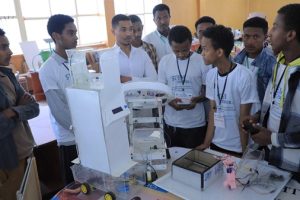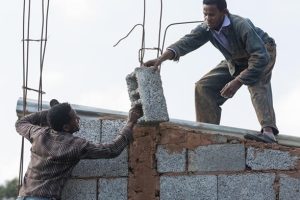BY GETACHEW MINAS
Children living in areas of armed conflict are frequently deprived of basic needs, supportive environment and educational opportunities. They are also lacking other resources that promote positive psychosocial development and mental health. Interventions have been designed to prevent or reduce the psychological challenges faced by conflict-affected children and youth. There are both challenges and opportunities related to addressing the mental health needs of children and youth. Documents have been prepared to promote international awareness of the impact of war and conflict on children and youth. However, in Northern Ethiopia, there were thousands of children living in war zones and regions occupied by the TPLF junta. Terror had reigned in these areas, forcing children to be disproportionately affected by armed conflict, making it a priority for the international aid.
Conflict experiences, ranging from inaccessibility of resources to forced engagement with armed The burden of mental disorders among children might result from conflict-related neglect, abuse and exploitation, which have become disturbing phenomena. It was obvious that there would be disparities between the mental health of war-affected children and youth and those in conflict-free areas. Studies in other countries have identified the psychosocial functioning of conflict-affected children and youth. They also recommended interventions designed to prevent mental health problems as well as the mental health needs of these children and youth. It is possible to imply the different facets of the phenomena of conflict experienced by child soldiers forcibly engaged by the war-mongering TPLF in Ethiopia.
Experiencing armed conflict during childhood and adolescence poses serious mental health risks and threats to a child’s development. Exposure to different types of violence, the duration of the conflict, and the nature of traumatic events are all associated with the severity of mental disorders. The links between armed conflict exposure during childhood and subsequent mental health risks are well established. However, the prevalence of mental disorders varies widely from one conflict to the other. Studies reported the post-traumatic stress disorder (PTSD) prevalence among children exposed to civil wars. There are real differences in mental health problems due to variations in exposure to trauma of war. These variations may be attributed to cultural and environmental factors that influence mental distress. Ethiopian children residing in zones of conflict caused by the TPLF junta might be exposed to the same mental distress.
Overall, the most common mental disorders among children exposed to conflict were PTSD and depression. Other disorders might include acute stress reactions, panic disorder, anxiety disorders specific to childhood, and sleep disorders. In later childhood, children would be exposed to conflict-related trauma, including behavioral problems and mental disorders. Ethiopian children exposed to armed conflicts might experience symptoms of disorder that might increase with age, with school-age children being the most vulnerable. The effects of armed conflict reverberated through a child’s social development.
Manifestations of war trauma among children affected family interactions, peer relations, educational outcomes and satisfaction. Conflict-related disgrace and humiliation were widespread in many post-conflict settings caused by the TPLF junta in Ethiopia. These would exacerbate mental health problems in the northern part of the country. The effects of armed conflict might have negatively affected children’s ability to demand basic social support and resources. Experiences of other countries show that conflict and the post-conflict environment could negatively affect mental health. However, the presence of protective factors including family and community “acceptance” might prevent the negative effects of war.
Recruitment and use of children by the TPLF junta to serve it as soldiers was a serious violation of children’s rights. The number of child soldiers had increased tremendously in areas controlled by the junta. Ongoing war, conflicts and persistent unrest exposed children to the risk of forced military service. Child soldiers were exposed to high levels of violence, including forced participation in warfare. The mental health of these soldiers had been severely affected as compared to children that were never conscripted. This would lead to high prevalence of mental health problems among child soldiers that would last throughout their life span.
Mental health among child soldiers would continue to be negatively affected even after they have been reintegrated and accessed family support and economic opportunity. Post-conflict maltreatment of children might be continued with violence during and after the war. They might be exposed to rape during conscription which would result in depression afterwards. The experiences of child soldiers, in addition to post-conflict factors, community rejection and disgrace, and social disrespect might cause mental health risks. In this regard, children in the localities invaded by the TPLF junta might also be subjected to mental health problems.
Several interventions might be conducted by the state to promote health development of children. Childhood interventions might help to counter deficiencies and stresses faced by young soldiers in post-war era. The role of their families in promoting positive development during the critical years of life is very crucial. These families should target the physical, emotional, social and mental developments which might facilitate school readiness of their children. This would require economic development of the parents through parent education and skills development. These interventions should aim to strengthen parents’ ability to prevent new problems through developing skills that would improve parental care for children affected by war. These measures have to focus on both children and their family.
When a war came to an end, governments had to issue guidelines on the use of treatment techniques that would address challenges and a range of mental health interventions. These measures should focus on risk factors, such as child mental and behavioral deficits or parental caregiving skills. Special emphasis had to be given to the importance of preventing or reducing family separation. “Parental” presence which was critical for the mental health of children was unimaginable in areas affected by the warring TPLF regime. Effective early childhood interventions would be beneficial for addressing multiple sociological influences and child rights, but this could not be implemented in Ethiopia during the rule of the junta.
UN convention on children emphasized SAFE which was an acronym that focused on the urgency of understanding the interdependence of four elements of children’s basic security needs and rights. These are: safety/freedom from harm (S), access to basic physiologic needs and health care (A), family connection with others (F), and education and economic security (E) for the children. Intergenerational home visiting addressed the needs of both children and caregivers. It was indicated that family-environment promoted protective elements of parent/child relationships and increased access to hard-to-reach populations.
In post-genocide situation, family strengthening interventions had demonstrated “improvements” in parent/child relationships, child nutritional status and parenting behaviors related to violence. Such family-based preventive interventions applied to war-affected communities, especially when integrated into social protection, health and education systems to ensure greater access. The effectiveness of child-friendly interventions had promoted the mental and psychosocial well-being of young children. Also, individual-level or group-based interventions might be necessary and acceptable. Art therapy carried out by trained mental health practitioner promised longer-term healing and enhancing of community resilience.
Kindergartens, schools, and clinics were indicated as a focal point for intervention. In war-torn countries, a trauma-focused behavioral therapy had been delivered by trained counselors to affected children. This had contributed to significant reductions in trauma symptoms and improvement inactivities of children. The overwhelming basic needs of vulnerable communities such as food and shelter have made the implementation and evaluation of mental health interventions for war-affected youth extremely challenging. However, there had been promising treatment approaches for school-aged youth. Such interventions could broadly be categorized as having a sociological orientation, delivered in individual or group-based situations, or school settings.
In war affected countries, interventions targeting age groups assume that youth’s family and community might be within the treatment zone. Community-based programs incorporated a life skills leadership projects, including relaxation and mobile cinema screenings to address humiliation and disgrace of children. Each youth participant was encouraged to bring one caregiver or family member to the sessions to strengthen pro-social behavior and decrease social problems. Studies revealed that the youth who received services reported significant reduction in traumatic stress reactions than those who did not receive. There were reductions in symptoms and a decline in misbehavior, with increased pro-social behaviors.
An innovative intervention was the use of community “advisory” boards comprised of community leaders and local youth to address challenges that arose during implementation. The board provided feedback on the appropriateness of its interventions. This strategy of incorporating community advisory boards into mental health interventions was well aligned with war-affected populations, in which humanitarian workers and affected communities built equitable partnerships that served to support and empower vulnerable communities.The advisory board members gained experience in their engagement with communities that had suffered from the effects of war or civil strife.
Interventions had also prioritized an individual or group-based approach to treatment. A narrative exposure therapy (NET) was developed to be a brief treatment for the psychological torture and other forms of “organized violence” that could be delivered by elders in low-resource areas. The main intervention element of NET was the construction of a trauma narrative. This had been a successful treatment for former child soldiers, refugees and orphans. NET, as compared to other forms of treatment resulted in a significant reduction in PTSD, which were enhanced over time. It was a mental health intervention that consisted of promoting youth skills for preventing traumatic experiences. This applied to all countries, and it should be introduced in Ethiopia, where the TPLF junta had engaged child soldiers in its war of aggression against the people and government of the country.
THE ETHIOPIAN HERALD THURSDAY 4 AUGUST 2022





